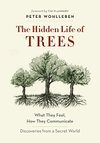The Hidden Life of Trees: What They Feel, How They Communicate—Discoveries from A Secret World (The Mysteries of Nature Book 1)
amazon.com
Saved by maddispatch and
The Hidden Life of Trees: What They Feel, How They Communicate—Discoveries from A Secret World (The Mysteries of Nature Book 1)

Saved by maddispatch and
And what is the point of all this? Deep down inside, do trees secretly appreciate beauty? Unfortunately, I cannot say, but what I can tell you is that there is a good reason for this ideal appearance: stability. The large crowns of mature trees are exposed to turbulent winds, torrential rains, and heavy loads of snow. The tree must cushion the
... See moreIf you are a tree, slow growth is the key to growing old. Growth fueled by hefty additions of excess nitrogen from agricultural operations is unhealthy. And so the tried and tested rule holds true: less (carbon dioxide) is more (life-span).
The surprising result: the older the tree, the more quickly it grows. Trees with trunks 3 feet in diameter generated three times as much biomass as trees that were only half as wide.42 So, in the case of trees, being old doesn’t mean being weak, bowed, and fragile. Quite the opposite, it means being full of energy and highly productive. This means
... See moreThese fungi are mutualistic. They connect the trees with the soil in a market exchange of carbon and nutrients and link the roots of paper birches and Douglas firs in a busy, cooperative Internet. When the interwoven birches and firs were spiked with stable and radioactive isotopes, I could see, using mass spectrometers and scintillation counters,
... See moreBecause their wood is composed of large cells grown in haste, it contains a lot of air, and so the destructive fungal filaments can spread quickly. The trunk rots big time, and because pioneer species often stand out in the open alone, it’s not long until the next fall storm topples the tree. This is not a tragedy for the species itself. Its goal
... See moreWhat’s really surprising is how much betulin there is in birch bark. A tree that makes its bark primarily out of defensive compounds is a tree that is constantly on the alert. In such a tree there is no carefully calibrated balance between growth and healing compounds. Instead, defensive armoring is being thrown up at a breakneck pace everywhere.
... See moreNow, the beech is an amazingly socially oriented tree, but only when it comes to its own kind. Beeches harass other species, such as oaks, to such an extent that they weaken. It all starts quite slowly and harmlessly when a jay buries a beechnut at the feet of a mighty oak. Because the jay has enough food cached away elsewhere, this beechnut lies
... See moreTrees, it turns out, have a completely different way of communicating: they use scent.
The saliva of each species is different, and trees can match the saliva to the insect. Indeed, the match can be so precise that trees can release pheromones that summon specific beneficial predators. The beneficial predators help trees by eagerly devouring the insects that are bothering them.